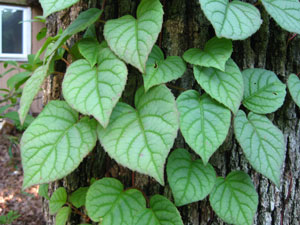Resource Library
Plant of the Week: Vine, Japanese Hydrangea
The University of Arkansas System Division of Agriculture does not promote, support or recommend plants featured in "Plant of the Week." Please consult your local Extension office for plants suitable for your region.
Plant of the Week
Japanese Hydrangea Vine
Latin: Schizophragma hydrangeoides

Vines both intrigue and frighten me. They can be uniquely beautiful, but some can become threateningly aggressive, as any wisteria grower will tell you. Of late, I have made the acquaintance of the Japanese hydrangea vine (Schizophragma hydrangeoides), a vine that has so far provided the promise that vines offer without threatening to take over.
Japanese hydrangea vine is one of 10 species in the hydrangea family but is only a cousin of the more common climbing hydrangea, Hydrangea anomala subsp. petiolaris. Schizophragma is a fast-growing, freely climbing vine that adheres tightly to a wall or tree trunk by means of modified aerial roots. As the vine ages, the stems have peeling, cinnamon-colored bark and provide winter interest, but are not so effective as the true climbing hydrangea.
The long-petioled, heart-shaped leaves are arranged oppositely on the stem. Leaf blades are 2.5 to 3 inches long and wide with the red-tinted petioles of equal or greater length. Leaf margins are coarsely serrate and come to a fine tip. ‘Moonlight’ is the selection growing in my garden, and it is characterized by having a pewter-colored upper leaf surface marked with narrow, green veins.
Eight-inch wide flower heads containing numerous tiny, fertile flowers are surrounded by solitary, sterile-white, ovate-shaped bract that are to 1.25 inches long and produced on long petioles. The flower effect is similar to lacecap hydrangea blooms, but in hydrangea the sterile florets contain four bracts, not the solitary one seen in Schizophragma. Blooms appear in late spring or early summer, but vines must be well established before they produce flower heads. ‘Roseum’ has rose-colored bracts.
Climbing hydrangea vines are considered the most attractive of all vines, though they are seldom met with in southern gardens. In the true climbing hydrangea, the vine is three-dimensional; it climbs a flat surface, but when it begins flowering, it produces a scaffolding of cinnamon-colored, exfoliating branches that protrude from the wall or the tree trunk 12 to 16 inches. Schizophragma is a two-dimensional vine, growing 20 feet tall and wide on an open wall, but it does not protrude outward on scaffold branches when it flowers.
Schizophragma was first described in 1836 from material collected by Dr. Philipp von Siebold (1791-1866) while in Japan. Nine species are described as native to China, but Schizophragma hydrangeoides does not occur there. It apparently did not catch on in gardens until the early years of the 20th century, and even then it remained rare as it is today. The unwieldy Latin name translates as “divided fragments” in reference to the way the fruit capsule separates when it matures. The mental disorder schizophrenia has the same Greek base word, for the divided personality disorder.
The Japanese hydrangea vine is easy to grow in any reasonably fertile, non-droughty soil. It is hardy in zones 5 through 8 and grows in either full sun or partial shade. Probably the best place for a climber such as this is on the north wall of a brick or stone structure, where it gets good sky light but not direct sun. The water falling from the roof will provide the moisture the plant prefers. I have seen no sign of stress, even though my plant is growing on the trunk of an oak tree that must provide pretty intense competition for water.
By: Gerald Klingaman, retired
Retired Extension Horticulturist - Ornamentals
Extension News - May 13, 2011
The University of Arkansas System Division of Agriculture does not maintain lists of retail outlets where these plants can be purchased. Please check your local nursery or other retail outlets to ask about the availability of these plants for your growing area.